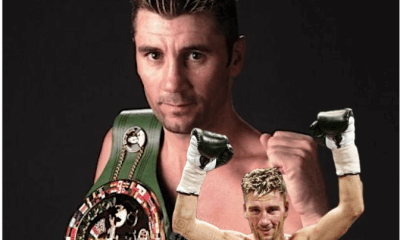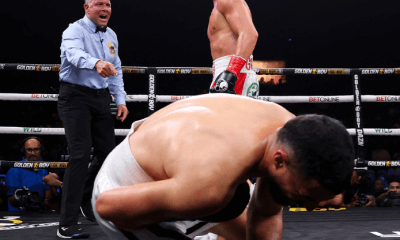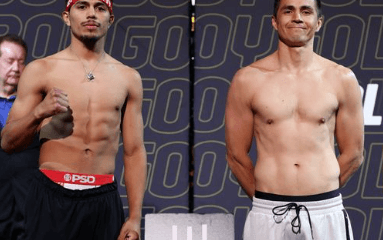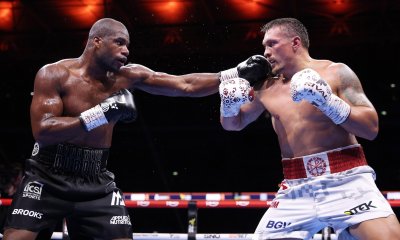Canada and USA
Dave Zirin, Jim Brown, and Muhammad Ali
Muhammad Ali and Jim Brown created a new template for athletes: competitors who were big, strong, and fast. They also heralded a more aggressive approach on the part
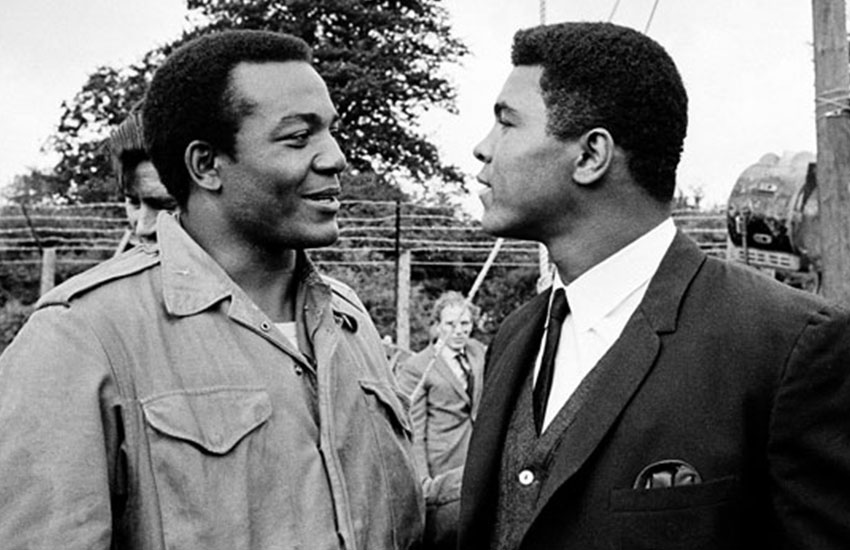
Muhammad Ali and Jim Brown created a new template for athletes: competitors who were big, strong, and fast. They also heralded a more aggressive approach on the part of black athletes in confronting the status quo on racial issues.
Millions of pages have been written about Ali’s excellence as a fighter and his impact on society. Brown has been less fully explored. Jim Brown: Last Man Standing by Dave Zirin (Blue Rider Press) gives Brown his due as a football player but keys on his social importance.
Brown is a symbol of things good and bad: personal pride, black empowerment, athletic supremacy, and the worst kind of misogyny. He has special credence and is more remarkable in some ways because he’s regarded by many knowledgeable observers as the greatest football player of all time.
Brown played with the Cleveland Browns from 1957 through 1965. His career, Zirin writes, was “Homeric” and “marked by feats that still make grown men shudder with joy.”
In nine seasons, Brown led the league in rushing eight times. He’s the only player in NFL history to average one hundred yards rushing per game over the course of his career and the only running back to average more than five yards each time he carried the ball. Remarkably, despite the fact that he touched the ball on sixty percent of Cleveland’s offensive plays, he never missed a game due to injury.
“To understand how Jim Brown was able to make such an enduring political impact,” Zirin states, “we first have to understand the awe he inspired inside the lines. On offense, the all-time great skill players have inspired astonishment yet never physical fear. On that side of the line of scrimmage, the list of true intimidators begins and ends with Jim Brown.”
As Brown’s football-playing days wound down, he segued into acting with significant roles in films like The Dirty Dozen, Rio Conchos, Ice Station Zebra, 100 Rifles, and a string of “blaxploitation” movies. He was a serviceable actor with a commanding screen presence and one of Hollywood’s first black action heroes. That fit nicely with his standing as a forceful advocate for black empowerment.
Brown, Zirin writes, “represented the seedlings of ‘Black Power’ a decade before the phrase was popularly known.”
In an era when sports unions were virtually non-existent, he led the movement for player rights within the Cleveland Browns organization. That led to complaints that Brown was a “locker room lawyer” and causing racial problems within the team.
“One man’s racial problem is another man’s equal rights,” Brown responded.
He elaborated on that theme in a 1964 autobiography entitled Off My Chest, writing, “I do not crave the white man’s approval. I crave only the rights I’m entitled to as a human being. The acceptance of the Negro in sports is really an insignificant development that warms the heart of the Negro less than it does of the white man who salves his troubled conscience by telling himself, ‘Isn’t it wonderful that Negroes and whites are out there playing together.’”
In 1965, Brown formed the Negro Industrial and Economic Union, later known as the Black Economic Union. Between 1965 and 1972, the BEU had offices in six cities and helped launch more than four hundred black-owned businesses. Brown’s stated aim in forming the organization was “to make more black Americans rich and powerful. We wanted them spending their hours building their economics and to stop marching, singing, kneeling, and praying.”
In that regard, Zirin notes, “Brown was not looking for a movement or to attach himself to anyone else’s agenda. He was an organizer, not a movement builder. He worked to see the black community assert its economic independence and fight racism, but also looked at the existing manifestations of the ‘fight against racism’ – marching, demonstrating, even arming yourself for revolutionary ends – and saw a waste of everyone’s time.”
Thus, over the years, Brown has mocked the civil rights movement as “parades” and declared, “If I ever march, I’ll march alone.” He has declared his antipathy for the movement anthem – We Shall Overcome – with the observation, “I hated that song. It was about marching and singing. I didn’t like marching. I didn’t march. And I didn’t like singing to get my freedom. To me, that was weak.”
Even today, Brown reaffirms, “I didn’t think much of Dr. King. If you think about a majority of the rhetoric, it’s about what’s being done to us. It doesn’t have damn near anything that says what we’re going to do for ourselves.”
And how did Brown weigh the civil rights movement against dollars?
One of many interesting episodes in Zirin’s book recounts how Olympic sprinter Tommie Smith planned to try his hand at pro football after the 1968 Olympics. Prior to the games, Brown agreed to represent Smith as his agent and loaned him $2,000 against future earnings. Smith won a gold medal in the 200-meter sprint in Mexico City and, with silver medalist John Carlos, raised his fist in a protest against racism during the medal ceremony. That made him persona non grata in the NFL. Brown demanded return of the $2,000 and refused to represent Smith.
The Black Economic Union lost steam in the early 1970s. Eventually it was supplanted by Amer-I-Can as the focal point of Brown’s efforts to impact on society. Brown invested $400,000 of his own money to launch Amer-I-Can. Its stated mission is to foster individual improvement and combat gang violence. On numerous occasions, he has offered his California home as a site for negotiations among rival gangs.
No book about Brown would be honest or complete without an examination of his chronic mistreatment of women. Zirin doesn’t shrink from the task of recounting what he calls his subject’s “toxic violence” against women.
Brown had a badly fragmented home life during his formative years and was largely neglected by his mother. He was not a good family man during his first marriage, which lasted on paper from 1959 through 1972, and ignored his children from that marriage for much of their lives.
Again and again, Zirin makes the point that the central theme of Brown’s life – from the way he played football to his struggle for black empowerment – has been about Brown’s view of ”manhood.”
“Proving his manhood through fatherhood,” Zirin explains, “was not nearly as enticing as doing it through sexual conquest.”
Almost a decade after their divorce, Sue Jones Brown recalled, “Before we got married, he said there was always going to be other women. He said, ‘I’m Jim Brown. I can marry anybody in the world, and there are always going to be other women. Can you deal with that?’ I said I could, and I did.”
Throughout his adult life, Brown has consistently stated a preference for sexual partners who are considerably younger than he is. At age 53, he wrote in Out of Bounds (his second autobiography), “Physically, between a young girl and an old one, there is no contest. I don’t like being told what I’m supposed to want. I prefer girls who are young. My lady right now is nineteen.” He also referenced his Hollywood home as a place for “creative orgies,” acknowledging, “I’ve had up to eight girls in my room, maybe four on my couch and four on my bed. I might have sex in one night with four or five of them. But only if Jim Junior was feeling exceptional. Some people think that makes me a pervert. I think it makes me lucky.”
But Brown’s sexual conduct has extended beyond sleeping around.
Under Brown’s “man code,” Zirin writes, “Women were often his pastime, his distraction, his proving ground, and at times the repository for his frustrations, existing only as extensions of desire for either sex or violence.”
In 1965, an 18-year-old woman named Brenda Ayers accused Brown of assault, claiming that he “forced an unnatural sex act” on her. He was tried and acquitted of the charges against him. The following year, Ayers filed a paternity suit. Brown, in Zirin’s words, “hired a team of top attorneys that Ayers could not hope to match” and prevailed in court. Twenty-four years later, Brown publicly acknowledged that the child was his.
Also in 1965, an Ohio State coed filed a rape charge against Brown but withdrew the charge before the case came to trial.
In 1968, Brown was alleged to have thrown a 22-year-old model named Eva Bohn-Chin off a hotel balcony in Los Angeles to a concrete walk twenty feet below. The police found blood on the floor and walls of Brown’s hotel room. Initially, he was charged with attempted murder. But the charges were dropped when Bohn-Chin refused to testify against him.
In 1971, he was accused of battery by two young women.
In 1985, a schoolteacher named Margot Tiff alleged that Brown beat and raped her when she refused to have sex in a menage a trois with him and another woman. The district attorney in Los Angeles chose to not prosecute the case.
In 1986 (when Brown was fifty), his then-fiancee, 21-year-old Debra Clark, accused Brown of assaulting her.
Brown married for the second time in 1997 at age 61. Two years later, he was arrested after smashing the window of his 25-year-old wife’s car in a fit of rage. He was convicted of vandalism and given the choice of spending six months in prison or accepting a three-part alternative package consisting of (1) four hundred hours of community service or forty hours of cleaning streets, (2) paying $1,700 to a domestic abuse charity, and (3) undergoing counseling for anger management. He chose prison rather than acknowledge that his conduct was related to domestic violence.
That was consistent with Brown’s constant denial of the accusations that have been leveled against him by women. But as Zirin observes, “The cases against Brown are extensive. He has often said that he has never been convicted of violence against women, which is true. Yet the cases span the years from 1965 through 1999. It’s a remarkable stretch that cannot be written off as just an endless series of law-and-order conspiracies, coincidences, or bad luck. Even without convictions of violence against women, there are enough 911 tapes and testimonials to see that this is not a fantasy created by those trying to destroy him.”
There are also Brown’s words from a 2014 interview, when he said, “All rejection is difficult to take, and who rejects you more than a f****** woman?”
“The history of accusations of violence against women,” Zirin concludes, “has scarred Brown’s legacy. Barack Obama – who as president took a particular joy from his regular interaction with black sports heroes of yesteryear – never dialogued with Brown. Donald Trump, however, rolled out the red carpet. In December 2016, the president-elect sat with Brown and former NFL player Ray Lewis [who, in 2000, pled guilty to obstruction of justice in conjunction with the police investigation of a double murder]. Brown left the meeting saying, ‘I fell in love with [Trump] because he really talks about helping black people.’”
And now we come to Brown’s relationship with Muhammad Ali.
Brown was never a member of the Nation of Islam, but he was comfortable with people who were. On February 25, 1964, hours after Cassius Clay dethroned Sonny Liston, the newly-crowned heavyweight champion sat in a room at a small black hotel called Hampton House with Malcolm X, singer Sam Cooke, and Brown. The four men talked for hours.
Brown later introduced Ali and Herbert Muhammad (Ali’s manager and the son of Nation of Islam leader Elijah Muhammad) to Bob Arum. Thereafter, a company called Main Bout Inc. was formed to promote Ali’s fights. Herbert Muhammad and John Ali (Elijah Muhammad’s top aide) controlled fifty percent of the stock. Brown had twenty percent. Closed-circuit guru Mike Malitz had twenty percent, and Arum had ten.
On April 29, 1967, Ali refused induction into the United States Army. Five weeks later, on June 4, Brown hosted a remarkable gathering.
“Ali had the opportunity to make a deal, to go into the service and not see combat,” Brown later reminisced. “And Herbert asked me to talk to him about it. I’ll tell you the truth. Herbert would not have minded Ali going into the Army, because they were starting to make good money together, and I didn’t think Herbert was necessarily wrong. If holding that meeting was a bad act, I wouldn’t have done it. But when a man makes a decision of that magnitude, he needs friends to help him sort things out. We wanted Ali to understand all the implications of his acts and make sure he was given a choice. So I called some people into Cleveland. John Wooten, Walter Beach, and Sid Williams, from the Browns; Willie Davis, Curtis McClinton, Bill Russell, Kareem Abdul-Jabbar, Bobby Mitchell, Jim Shorter. We met at my office. They were beautiful guys, and some of them thought Ali should go into the service. But he was adamant. He said simply, ‘I’m not going because it’s against my religion.’ And that was that. No one tried to convince him otherwise. We just wanted to discuss it with him, and I thought he showed tremendous courage.”
There’s an iconic photograph of that gathering. As described by Zirin, “Jim Brown, the greatest runner in NFL history and member of the 1964 champion Cleveland Browns, sits alongside the greatest winner in team sports history, Bill Russell of the Boston Celtics. Next to them is the linchpin of the most dominant team in college basketball history, twenty-year-old Lew Alcindor (later to be known as Kareem Abdul-Jabbar) of the UCLA Bruins. They are surrounded by a collection of black pro athletes. Also at the table is future Cleveland Mayor Carl Stokes. At the center of them all is Muhammad Ali.”
Dave Zirin is currently sports editor for The Nation and a columnist for The Progressive. His writing has long focused on the politics of sports. He researches thoroughly, writes clearly, and thinks creatively. Jim Brown: Last Man Standing is an honest, informative, and important book that lays bare what Zirin calls “the collision of Brown’s greatness and his flaws.”
Zirin’s book also brought back memories for me of time that I spent talking with Brown. I was researching the book that ultimately became Muhammad Ali: His Life and Times. Brown was one of the people I wanted to talk with. Ali’s best friend, Howard Bingham, gave me Brown’s home telephone number and told Brown to expect my call. I called on the evening of May 11, 1989. Brown said he was busy but we could talk if I called back the following night.
He was true to his word. The next evening, we talked for almost two hours. Our conversation touched on a wide range of subjects: the night Cassius Clay won the heavyweight championship; the formation of Main Bout Inc.; the meeting in Cleveland after Ali refused induction; and more.
Brown’s thoughts that evening echoed themes that he has been passionate about for his entire life:
* “The nature of the controversy was that white folks could not stand free black folks. White America could not stand to think that a sports hero that it was allowing to make big dollars would embrace something like the Nation of Islam. But this young man had the courage to stand up like no one else and risk, not only his life, but everything else that he had.”
* “Ali was a true warrior. It was unbelievable, the courage he had. He wasn’t just a championship athlete. He was a champion who fought for his people. He was above sports; he was part of history. The man used his athletic ability as a platform to project himself right up there with world leaders, taking chances that absolutely no one else took, going after things that very few people have the courage to go after. Ali was involved in the Vietnam War. Ali was involved in the struggle for racial equality. The Boston Celtics weren’t involved in the 1960s. The Montreal Canadiens, the Green Bay Packers, the New York Yankees; they weren’t involved in that. From the standpoint of his ability to perform and his ability to be involved with the world, Ali was the most important sports figure in history. To do what he did, to achieve the pinnacle of his profession, to fight for freedom for black people, to perform while being ostracized and still be a champion; Jackie Robinson died from that, and Ali was able to prevail.
* “If you want to see man at his best, take a look at Ali in his prime. When Ali came back from exile, he became the darling of America, which was good for America because it brought black and white together. But the Ali that America ended up loving was not the Ali I loved most. I didn’t feel the same about him anymore because the warrior I loved was gone. In a way, he became part of the establishment. And I suppose, in a sense, there’s nothing wrong with that, because if you can come to a point where you make all people feel good, maybe that’s greater than being a fighter for black people. But I didn’t like it.”
Fast-forward to April 14, 1991. I was with Ali at a hotel in Philadelphia for a banquet commemorating the twentieth anniversary of the first Ali-Frazier fight. Late that afternoon, I went to the dining room to look around. The hotel staff was setting up. Howard Bingham was there, sitting on the edge of a table, talking with a man who was wearing a tuxedo and a green-black-and-red kufi.
“This is someone you should meet,” Howard told me.
Because the man was sitting, I didn’t realize how big he was.
“I’m Jim,” the man said.
He stood up and extended his hand.
And the realization hit.
“Jim Brown,” I blurted out.
“No,” he corrected. “Just Jim.”
I‘ve thought about that moment many times since then, most notably on June 9, 2015, just before Game 3 of the NBA Championship Finals between the Cleveland Cavaliers and Golden State Warriors.
Dave Zirin sets that scene: “The Cavs are at home in Cleveland after two games in Oakland, attempting to finally remove the ‘God hates Cleveland’ curse from the city. No Cleveland sports team has won a title since that day in 1964 when the Browns shut out the Baltimore Colts 27-0. The current star of Cleveland, LeBron “King” James, a person so physically imposing he looks like a twenty-first century incarnation of a Greek god in African skin, took a moment before the start of the game to turn to a man sitting courtside. In front of the raucous packed house and a national television audience, the King bowed.”
Jim Brown is now 82 years old. Mundane acts such as turning a doorknob are difficult for him. He walks with the assistance of two canes. But on this day, with both teams on the court just prior to the tip-off for one of the biggest games in Cleveland history, LeBron James turned toward Brown and bowed.
Just Jim.
Congratulations to Dave Zirin on a job well done. He has put us on the road to better understanding this complex formidable man
Thomas Hauser can be reached by email at thauser@rcn.com. His most recent book – There Will Always Be Boxing – was published by the University of Arkansas Press. In 2004, the Boxing Writers Association of America honored Hauser with the Nat Fleischer Award for career excellence in boxing journalism.
Check out more boxing news on video at The Boxing Channel
-

 Featured Articles2 weeks ago
Featured Articles2 weeks agoResults and Recaps from New York Where Taylor Edged Serrano Once Again
-

 Featured Articles2 weeks ago
Featured Articles2 weeks agoResults and Recaps from NYC where Hamzah Sheeraz was Spectacular
-

 Featured Articles3 weeks ago
Featured Articles3 weeks agoFrom a Sympathetic Figure to a Pariah: The Travails of Julio Cesar Chavez Jr
-

 Featured Articles2 weeks ago
Featured Articles2 weeks agoPhiladelphia Welterweight Gil Turner, a Phenom, Now Rests in an Unmarked Grave
-

 Featured Articles6 days ago
Featured Articles6 days agoManny Pacquiao and Mario Barrios Fight to a Draw; Fundora stops Tim Tszyu
-

 Featured Articles3 weeks ago
Featured Articles3 weeks agoCatterall vs Eubank Ends Prematurely; Catterall Wins a Technical Decision
-

 Featured Articles5 days ago
Featured Articles5 days agoArne’s Almanac: Pacquiao-Barrios Redux
-
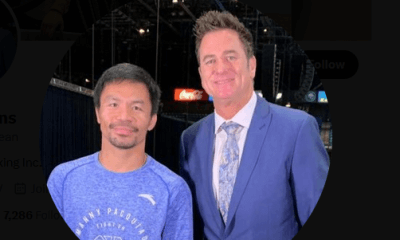
 Featured Articles2 weeks ago
Featured Articles2 weeks agoFrom the Boondocks to the Big Time, The Wild Saga of Manny Pacquiao’s Sidekick Sean Gibbons


